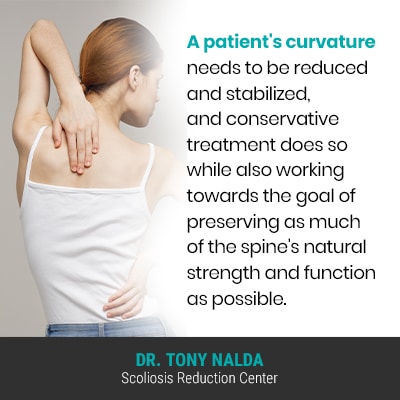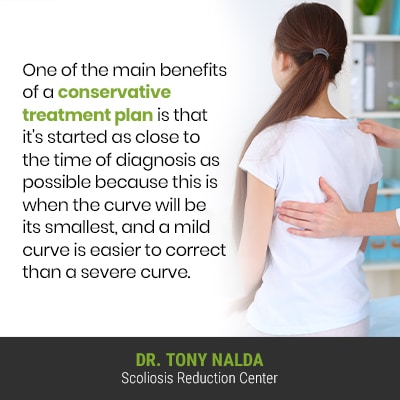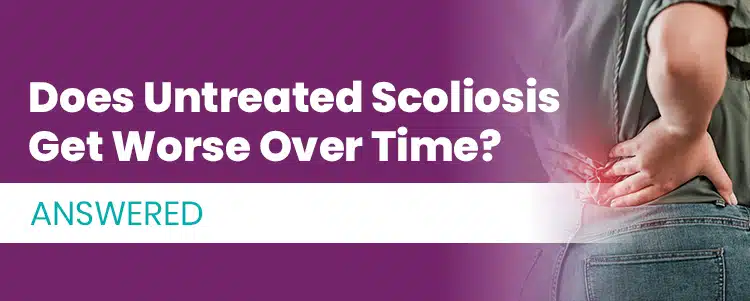The most important decision a patient has to make following a diagnosis of scoliosis is how to treat it, and this is important because different treatment approaches offer different potential results, and the choice to commit to one type of treatment over another can shape the spine’s long-term health and function.
Scoliosis is a progressive condition, and that means its nature is to get worse over time, but when a diagnosis is met with proactive treatment, it can be highly treatable. Scoliosis can range from mild to moderate and severe to very severe; only effective treatment can work towards counteracting the condition’s progressive nature.
Untreated scoliosis is virtually guaranteed to get worse over time, so let’s talk about treatment options.
What is Scoliosis?
With estimates at close to seven million people currently living with scoliosis in the United States alone, it’s a highly-prevalent spinal condition that warrants awareness.
While early detection doesn’t guarantee treatment success, it does increase its likelihood.
Scoliosis involves the development of an unnatural sideways-bending and rotating spinal curve; a scoliotic spine twists, and the rotational component makes it a complex 3-dimensional condition.
Scoliosis is diagnosed through a combined physical examination that involves taking the patient’s family history and performing an Adam’s forward bend test and the results of a scoliosis X-ray that shows what’s truly happening in and around the spine, along with confirming the patient’s Cobb angle.
Being diagnosed with scoliosis means facing life with a progressive condition whose nature is to get worse over time, so where a scoliosis is at the time of diagnosis isn’t indicative of where it will stay.
As scoliosis progresses, the size of the unnatural spinal curve is increasing, as are the condition’s uneven forces, and their effects.
How Bad Can Scoliosis Get?
Scoliosis ranges in severity from mild to moderate and severe to very severe, and condition severity is determined by a measurement known as Cobb angle.
A patient’s Cobb angle is determined during X-ray and tells me how far our of alignment a patient’s spine is, along with how severe the condition is.
The higher the Cobb angle, the more unnaturally tilted the spine’s vertebrae are, and the more noticeable the condition’s effects are likely to be:
- Mild scoliosis: Cobb angle measurement of between 10 and 25 degrees
- Moderate scoliosis: Cobb angle measurement of between 25 and 40 degrees
- Severe scoliosis: Cobb angle measurement of 40+ degrees
- Very-severe scoliosis: Cobb angle measurement of 80+ degrees
Even scoliosis that’s diagnosed as mild can easily progress and become moderate, severe, or very severe scoliosis, particularly if left untreated, or not treated proactively.
Scoliosis treatment options include traditional scoliosis treatment or modern conservative scoliosis treatment.
Let’s talk about the differences between an approach that involves surgical intervention and one that’s less invasive and chiropractic-centered, with a focus on how each works towards managing progression.
Traditional Scoliosis Treatment
Traditional scoliosis treatment has the goal of stopping scoliosis progression, and it does this through first attempting to impact the condition with traditional bracing, and when/if that is unsuccessful, spinal fusion surgery is commonly recommended.
Spinal fusion surgery involves fusing the curve’s most-tilted vertebrae into one solid bone so they can’t become more tilted over time, and commonly, rods are attached to the spine with pedicle screws to hold it in place.
A spinal deformity that’s addressed by the spine being repositioned through artificial means is contrary to the spine’s natural movement-based design, so the procedure is bound to affect the spine’s health, and a fused spine is fused for life.
If the surgery proves unsuccessful, the only recourse is more surgeries, and the risk factors only increase with each subsequent procedure, and increasing age (older adults also have natural age-related spinal degeneration to contend with).
While each patient’s response to scoliosis surgery is as unique as the patient themselves, many are disappointed with the loss in spinal flexibility and range of motion they experience as a result of the fused spine.
In addition, many patients find the increased spinal rigidity to be painful and disruptive, and a fused spine is also weaker and more vulnerable to injury.
So how does a different treatment approach that doesn’t include surgical intervention prevent scoliosis from getting worse?
Conservative Scoliosis Treatment

Conservative scoliosis treatment is integrative, and here at the Scoliosis Reduction Center®, I combine multiple scoliosis-specific treatment disciplines to impact conditions on every level.
Not only does scoliosis range so widely in severity from mild scoliosis to very severe cases, there are also different types of scoliosis a patient can develop.
The most prevalent type of scoliosis is idiopathic scoliosis, meaning not clearly associated with a single-known cause, and this accounts for approximately 80 percent of known diagnosed cases, and the remaining 20 percent are associated with known causes.
Cases of scoliosis with known causes are considered atypical as there is an underlying pathology at play, and this involves neuromuscular scoliosis, degenerative scoliosis, and congenital scoliosis.
Scoliosis affects all ages, but childhood scoliosis is more common, and adolescent idiopathic scoliosis is the most prevalent type overall, and it affects children between the ages of 10 and 18.
While we don’t know what causes idiopathic scoliosis to develop initially, we know what triggers its progression: growth spurts.
Adolescents are the most at risk for rapid progression because of the rapid and unpredictable growth spurts of puberty.
A patient’s curvature needs to be reduced and stabilized, and conservative treatment does so while also working towards the goal of preserving as much of the spine’s natural strength and function as possible.
Chiropractic Care
Scoliosis-specific chiropractic care works towards impacting the condition on a structural level by repositioning the curve’s most-tilted vertebrae back into alignment with the rest of the spine.
Through a number of techniques and manual adjustments, areas of vertebral subluxation can be addressed, and quality of life can be improved.
Physical Therapy

Along with impacting conditions on a structural level, I also want to provide the spine with better support and stabilization, and for that, I look to the spine’s surrounding muscles; it’s not just the spine that has to maintain its natural curves and alignment, but also a strong core.
Through physical therapy, and a variety of therapies, I can help patients improve the strength of the spine’s surrounding muscles so they can optimally support it, and through scoliosis-specific exercises, I can also improve bad posture, relieve pain, and minimize the symptoms of scoliosis and potential complications.
Corrective Bracing
Corrective bracing is particularly effective on growing spines and can help by pushing the spine into a straighter position, complementing other types of treatment.
Here at the Center, the brace of choice is often the ScoliBrace, and this represents the culmination of what we’ve learned about bracing efficacy over the years, along with addressing many of the shortcomings associated with traditional bracing.
Rehabiliation
Rehabilitation can involve continued chiropractic care and a series of custom-prescribed home exercises to help patients further stabilize and heat their spines from home.
One of the main benefits of a conservative treatment plan is that it’s started as close to the time of diagnosis as possible because this is when the curve will be its smallest, and a mild curve is easier to correct than a severe curve.
Conclusion
The most important condition characteristic for patients and families to understand is that scoliosis is most likely going to get worse over time, and scoliosis may cause complications if left untreated and/or if particularly severe.
The signs and symptoms of scoliosis differ among different age groups; the most common sign of scoliosis in children is postural deviation (uneven shoulders, one shoulder blade protruding more, the development of a rib cage arch, uneven hips, a prominent lean to one side), and while adults also experience postural changes, the main symptom of adult scoliosis is pain.
Scoliosis becomes a compressive condition once skeletal maturity has been reached, when it tends to start causing back pain and pain that radiates into the extremities due to nerve compression.
Most activities are safe for people with scoliosis, but if left untreated, patients are at risk of developing complications such as excessive disc degeneration, breathing problems, digestive issues, headaches, migraines, and sleep problems.
As a progressive condition triggered by growth, scoliosis in children should be treated seriously, and curves that are detected and treated while mild are the simplest to treat, so the best time to start scoliosis treatment is always now.
The vast majority of people with scoliosis, whether a common form or atypical types, will have their condition progress; the best way to address scoliosis is to proactively work towards preventing progression, rather than attempting to work towards reversing its effects once they’re established.




